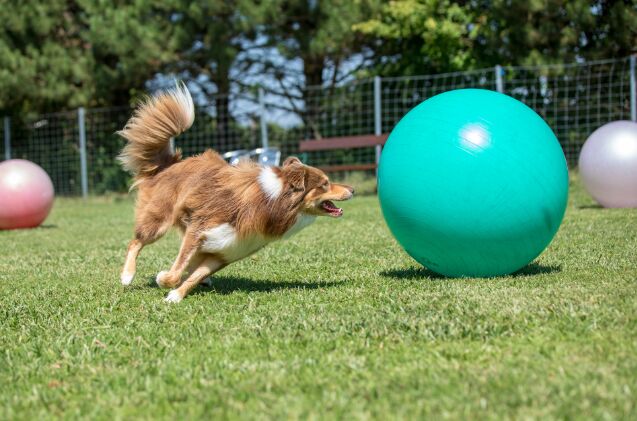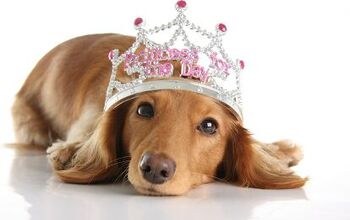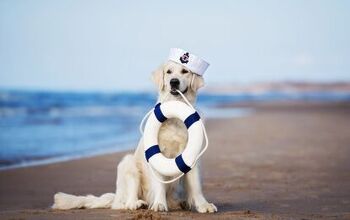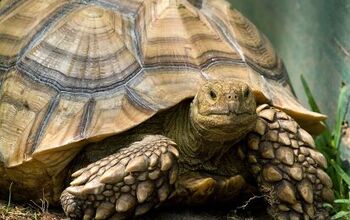Should Your Active Dog Use a Herding Ball?

If you have a dog with boundless energy, then you know the importance of finding activities that will captivate their attention and provide them with a healthy outlet.
For some dogs, this can be as simple as a favorite bone to chew on or a toy they can toss around and thrash until they wear themselves out. However, for those of us with active herding breeds, that isn’t enough to meet their needs and natural desires.
Herding balls are designed to tap into the instinct to “herd,” providing both mental and physical exercise.
In this post, we will discuss how to use a herding ball, why they are such an enticing object for many dogs, and how they can benefit your dog’s health. Plus, I’ll share which specific herding ball has earned the title of “best of the best” in our house, as determined by our German Shepherd/Australian Cattle Dog Lucifer.
So, let’s get into it…
What is a Herding Ball?
A herding ball is a large ball designed to be pushed, nosed, nipped at, and chased as if your dog is “herding it” around your yard or home. They are designed to prevent your dog from being able to carry it around. For this reason, they are too large, too heavy, or too difficult to pick it up.
They are often brightly colored and made from hard plastic or ballistic-strength material to withstand repeated nipping action.
While many dog parents will purchase these balls to be used around the home, they are best known for their use in the sport Treibbal (or urban herding). This challenges dogs to move and direct eight herding balls into a designated goal area in a limited time.
Why Do Dogs Like Herding Balls?
One of the most interesting things to witness is how quickly most dogs will take to a herding ball as if they naturally understand what they are supposed to do. But why do dogs love chasing these oversized balls around so much? Is this interest limited to just herding breeds?
There is no denying that herding breeds have the edge when it comes to mastering the herding ball. Why? The same actions used to move and direct the ball are used when herding livestock like sheep or cattle. Herding dogs have been bred for generation after generation to fine-tune these skills, making them better working dogs on ranches and in farm settings. This is also why herding breeds are often known to exhibit these herding tendencies in less-than-desirable ways, like nipping to herd other family pets or small children.
Some of the more popular herding breeds include:
- Australian Cattle Dog
- Australian Shepherd
- Belgian Malinois
- Border Collie
- Colie
- German Shepherd Dog
- Shetland Sheepdog
This isn’t to say that non-herding breeds aren’t going to enjoy the herding ball. Many non-herding breeds love playing with them. You will even see a wide assortment of breeds competing in Treibball competitions.
Do Herding Balls Offer Any Benefits for Your Active Dog?
Outside of being fun to play with, does a herding ball benefit your dog? Yes! As simple as the concept is, herding balls are a great source of physical and mental stimulation. Here are just a few of the benefits your dog can enjoy:
- Training impulse control, recall, and focus: As you teach your dog to obey commands and direct the ball in your desired direction, you are working on some key obedience skills.
- Work on body awareness: Teaching body awareness at a young age is a great way to improve coordination and prevent injuries. Of course, if you have an older dog and are just starting to introduce body awareness, there is no time like the present.
- Build strength and muscle tone: Of course, one of the main goals of physical activity is to help your dog stay strong, flexible, and toned. Working with a herding ball helps to prioritize all of these.
- Test problem-solving skills: This is an excellent form of mental enrichment. Studies have found that dogs who engage in problem-solving activities can slow the cognitive decline that comes naturally with aging.
- Offer a positive outlet for herding desires: By giving your dog a positive outlet to focus their herding instincts on, you can help them learn to channel these behaviors with the herding ball and not with your family cat.
- Strengthen your bond: As with any training, teaching your dog how to follow commands when herding the ball is a great way to spend time together and build a solid human-animal bond.
- Eliminate problem behaviors: Dogs that are bored or lacking enrichment often engage in destructive behaviors like barking, digging, and chewing on things they shouldn’t. By giving your dog time each day to play with the herding ball, you can tire them out and eliminate the stress that comes with pent-up energy.
How Do You Train a Dog with a Herding Ball?
Introducing a herding ball to your dog doesn’t necessarily have to involve training. Some dogs love nothing more than chasing the ball around and playing to their heart’s content. However, you can teach your dog to herd the ball on command if you want to incorporate training and obedience. To do this, you will need a large space, your herding ball, a marked “goal” of some time, a post-it note, and plenty of treats. For your goal marker, you could use small sports pylons, poles stuck in the ground (if training outside), or two chairs back-to-back to mark the sides.
Step 1 - Touch
You can teach this skill in several ways, but our preferred option is using the “touch” command. We have trained all our dogs this command as part of their basic training. The idea is that you can hold your hand out and give the command, and your dog will touch their nose to your palm, followed by a mark and reward.
Step 2 - Introduce the Post-it Note
You can then transition this “touch” to targeting a specific object – in this case, a Post-it note. Place the Post-it note on the palm of your hand, then give your dog the command. When their nose touches the paper, mark, and reward. Eventually, you can move the note to a wall or piece of furniture, roughly the same height as your hand is usually held, and carry out the same command there. Continue practicing until your dog willingly carries out the command wherever you place the note.
Step 3 – Transition from the Note to the Ball
Place the note on the side of your dog’s herding ball and practice your command. Slowly cut away small pieces of the Post-it, making it smaller and smaller over time until they associate touching the ball with getting a reward.
Step 4 – Start Moving the Ball
After your dog reliably touches the ball with their nose on command, you can start introducing the idea of moving. Step back from the ball as your dog touches the ball, marking and rewarding if it moves even a little bit. This will take patience, starting with the slightest movement and working up to your dog following you as you step backward. After your dog understands moving forward, you can introduce moving the ball left or right, adding verbal and/or hand commands.
The most common verbal commands used in Trieball are as follows:
- Moving forward towards you = “to me”
- Right-hand turns = “away to me”
- Left-hand turns = “come bye”
Step 5 – Add in the Goal
Finally, it’s time to add a specific purpose to your dog’s movements. Using the commands you’ve taught your dog, start directing your dog around the room and towards your goal. Make sure you have extra special rewards planned for when your dog “scores” at the end!
CollieBall – The Original Herding Ball
With Lucifer being a high-energy herding dog, we knew that we wanted to find ways to harness this energy in a positive way. Especially when we noticed his tendency to want to herd our cats (which we quickly put a stop to).
We tried several different options but quickly realized that the rigid plastic construction of most balls didn’t work well for us. Why? He would bite down hard and repeatedly when he got into the “zone” while playing. This worried us about the potential impact that trying to bite the ball could have on his teeth over time. Instead, we decided to try an inflatable ball and discovered the CollieBall. The cover of this ball is made from a strong 1680 Denier ballistic fabric.
Are Herding Balls Ideal for Every Dog?
While we could rave for days about how much we love the CollieBall in our house, it won’t work for every dog. If you have a dog that is older, experiencing mobility issues, recovering from an injury, or limited in their movement for any reason, you may want to think twice.
They are also not the best choice for dogs that are fixated on biting/destroying things. Inflatable balls like the CollieBall are surprisingly durable. However, a dog that is determined to destroy it will be able to eventually. Plastic herding balls may seem like a better solution, but their rigid construction could lead to dental problems by wearing down, cracking, or breaking teeth.
Final Thoughts
If you are looking for a fun way to burn some excess energy and entertain your dog, a herding ball is a great option. They offer physical and mental stimulation, helping to wear out even the most energetic dogs. You can take the mental enrichment to the next level by adding the training component and introducing your dog to the basics of Trieball. Most importantly, this is an excellent opportunity for you and your dog to get out and have fun together!

Britt Kascjak is a proud pet mom, sharing her heart (and her home) with her “pack” which includes her husband John, their 2 dogs – Indiana and Lucifer – and their 2 cats – Pippen and Jinx. She has been active in the animal rescue community for over 15 years, volunteering, fostering and advocating for organizations across Canada and the US. In her free time, she enjoys traveling around the country camping, hiking, and canoeing with her pets.
More by Britt
























